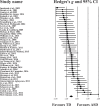Figurative language comprehension in individuals with autism spectrum disorder: A meta-analytic review
- PMID: 27899711
- PMCID: PMC5843023
- DOI: 10.1177/1362361316668652
Figurative language comprehension in individuals with autism spectrum disorder: A meta-analytic review
Abstract
We present a meta-analysis of studies that compare figurative language comprehension in individuals with autism spectrum disorder and in typically developing controls who were matched based on chronological age or/and language ability. A total of 41 studies and 45 independent effect sizes were included based on predetermined inclusion criteria. Group matching strategy, age, types of figurative language, and cross-linguistic differences were examined as predictors that might explain heterogeneity in effect sizes. Overall, individuals with autism spectrum disorder showed poorer comprehension of figurative language than their typically developing peers (Hedges' g = -0.57). A meta-regression analysis showed that group matching strategy and types of figurative language were significantly related to differences in effect sizes, whereas chronological age and cross-linguistic differences were not. Differences between the autism spectrum disorder and typically developing groups were small and nonsignificant when the groups were matched based on the language ability. Metaphors were more difficult to comprehend for individuals with autism spectrum disorder compared with typically developing controls than were irony and sarcasm. Our findings highlight the critical role of core language skills in figurative language comprehension. Interventions and educational programmes designed to improve social communication skills in individuals with autism spectrum disorder may beneficially target core language skills in addition to social skills.
Keywords: autism spectrum disorder; figurative language; meta-analysis; metaphor.
Figures


Similar articles
-
Can You Play with Fire and Not Hurt Yourself? A Comparative Study in Figurative Language Comprehension between Individuals with and without Autism Spectrum Disorder.PLoS One. 2016 Dec 30;11(12):e0168571. doi: 10.1371/journal.pone.0168571. eCollection 2016. PLoS One. 2016. PMID: 28036344 Free PMC article.
-
Comprehension of figurative language in Taiwanese children with autism: The role of theory of mind and receptive vocabulary.Clin Linguist Phon. 2015;29(8-10):764-75. doi: 10.3109/02699206.2015.1027833. Clin Linguist Phon. 2015. PMID: 25909823
-
Can you tell it by the prime? A study of metaphorical priming in high-functioning autism in comparison with matched controls.Int J Lang Commun Disord. 2017 Nov;52(6):766-785. doi: 10.1111/1460-6984.12314. Epub 2017 Mar 30. Int J Lang Commun Disord. 2017. PMID: 28371082
-
Figurative language processing in autism spectrum disorders: A review.Autism Res. 2024 Apr;17(4):674-689. doi: 10.1002/aur.3069. Epub 2023 Dec 10. Autism Res. 2024. PMID: 38071498 Review.
-
Language and motor skills in siblings of children with autism spectrum disorder: A meta-analytic review.Autism Res. 2017 Nov;10(11):1737-1750. doi: 10.1002/aur.1829. Epub 2017 Jul 7. Autism Res. 2017. PMID: 28685955 Review.
Cited by
-
Metaphor Comprehension in Individuals with Autism Spectrum Disorder: Core Language Skills Matter.J Autism Dev Disord. 2022 Jan;52(1):316-326. doi: 10.1007/s10803-021-04922-z. Epub 2021 Mar 10. J Autism Dev Disord. 2022. PMID: 33689089 Free PMC article.
-
Reasoning on Figurative Language: A Preliminary Study on Children with Autism Spectrum Disorder and Klinefelter Syndrome.Brain Sci. 2019 Mar 11;9(3):58. doi: 10.3390/brainsci9030058. Brain Sci. 2019. PMID: 30861991 Free PMC article.
-
Should We Continue to Tell Autistic People that Their Brains are Different?Psychol Rep. 2025 Jun;128(3):1315-1355. doi: 10.1177/00332941231174391. Epub 2023 May 5. Psychol Rep. 2025. PMID: 37147123 Free PMC article. Review.
-
Sublime and extended reality experiences to enhance emotional wellbeing for autistic people: A state of the art review and narrative synthesis.Int J Soc Psychiatry. 2024 Nov;70(7):1202-1210. doi: 10.1177/00207640241261172. Epub 2024 Jul 24. Int J Soc Psychiatry. 2024. PMID: 39049584 Free PMC article. Review.
-
Irony detection in patients with borderline personality disorder: an experimental study examining schizotypal traits, response biases and empathy.Borderline Personal Disord Emot Dysregul. 2022 Oct 4;9(1):24. doi: 10.1186/s40479-022-00194-w. Borderline Personal Disord Emot Dysregul. 2022. PMID: 36192806 Free PMC article.
References
-
- Ackerman BP. (1982) On comprehending idioms: do children get the picture? Journal of Experimental Child Psychology 33(3): 439–454.
-
- *Adachi T, Koeda T, Hirabayashi S, et al. (2004) The metaphor and sarcasm scenario test: a new instrument to help differentiate high functioning pervasive developmental disorder from attention deficit/hyperactivity disorder. Brain & Development 26(5): 301–306. - PubMed
-
- American Psychiatric Association (APA) (2013) Diagnostic and Statistical Manual of Mental Disorders: DSM-5. 5th ed. Arlington, VA: APA.
-
- *Au-Yeung SK, Kaakinen JK, Liversedge SP, et al. (2015) Processing of written irony in autism spectrum disorder: an eye-movement study. Autism Research 8: 749–760. - PubMed
-
- Baron-Cohen S. (2001) Theory of mind in normal development and autism. Prisme 34: 174–183.
Publication types
MeSH terms
LinkOut - more resources
Full Text Sources
Other Literature Sources
Medical

